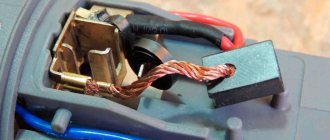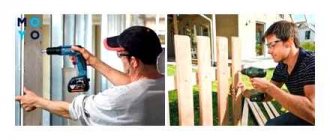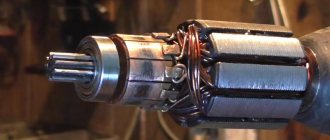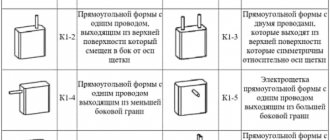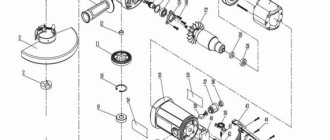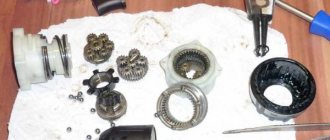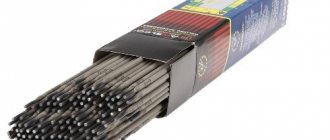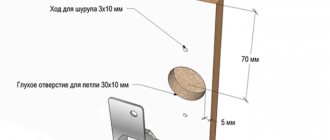All types of cutting machines with electric motors have a brush assembly. This is a bracket with carbon-graphite coins fixed on it, which are pressed against the collector rings. Through these elements, electric current flows to the rotor windings.
An electromagnetic field appears, due to which the angle grinder shaft begins to rotate. It turns the gears of the gearbox, and through them - the cutting or grinding wheels.
After using the grinder for a long time, sparks may begin to fly out of the brush assembly. This indicates that the carbon-graphite nickels are very worn out.
It is typical that the contact of their surfaces with the collector plane deteriorates. In this case, the power of the electric motor will drop significantly. You can feel this: if you press hard on the grinding wheel while cleaning parts, the electric motor of the angle grinder will stop rotating. If the wear of the brushes is critical, the grinder will not work.
What to do when worn out
You should make sure that the sparks are flying from the brush assembly. To do this, you need to inspect the body of the angle grinder. On some models, the brushes are installed externally, so you don’t have to disassemble the housing to replace them. These angle grinders have round plastic plugs with threads.
To unscrew them, you will need a large slotted screwdriver, the working side of which is placed in the groove of the plug. The plugs are carefully unscrewed counterclockwise. Then the brushes with springs are removed. New parts are purchased from construction or electrical supplies.
Since it will be difficult to determine the initial length of the brushes, you need to focus on:
- grinder model - you can find the necessary carbon-graphite nickels from online store catalogs;
- measuring the distance from the surface of the collector to the outer part of the seat, taking into account the thickness of the compressed spring and the brass contact plate;
- dimensions and cross-sectional shape of the brush.
If the name of the angle grinder model cannot be determined, then it is better to take the angle grinder with you and select brushes in the store.
But to replace the carbon-graphite pennies on other models of cutting machines, you will have to open the case. To do this, unscrew the screws, which can be located at the end - near the network cable or on the side plates and planes of the handle.
Plastic protective elements are either removed downwards through the cord, or moved to the sides.
Expert opinion
Torsunov Pavel Maksimovich
When disassembling the case, you need to be careful: often the power button is attached to the plastic elements of the handle. If you pull too hard, you can tear out the wires.
The brushes on such models of angle grinders are hidden in a bracket on the commutator. To dismantle the coal nickels, you will have to bend the brass plates or press on them and turn them slightly. The removal method depends on the model.
Many manufacturers include a spare set of carbon brushes in the shipping box.
Useful advice for unscheduled repairs of an angle grinder
Many people wonder what to do if they couldn’t find exactly the same brushes in the store that were installed in the angle grinder. You can simply buy larger brushes (a 1mm difference is normal) and grind them down to the desired size.
To perform this operation as accurately as possible, you will need to make a simple device. You need to secure the brush to a piece of chipboard, plywood (or other flat surface) using double-sided tape. The master tightens four self-tapping screws in the corners, recessing their heads below the surface of the brush by 0.5 mm.
In this case, the screw caps act as beacons. After this, use a block of sandpaper to remove excess graphite. If you grind the brush by eye, the surface may turn out uneven, which is undesirable.
You can watch the video on our website for details on how to change worn out brushes on an angle grinder yourself.
Secrets of angle grinder repair. How to change brushes on an angle grinder and where to get them.
Andrey Vasiliev
Ask a Question
Inspection of brushes and commutator surface
Before purchasing new carbon elements, you need to check whether the commutator surfaces are in good condition.
If a dark coating is visible on the surfaces, it needs to be cleaned with a stationery eraser. This carbon deposit was caused by overheating during operation.
And the result is a poor fit of the brushes to the plane.
Help: in some cases, a badly burnt collector cannot be “saved.” Even when installing new brushes, carbon deposits will appear again. Then you will have to change the entire rotor.
Then the coal nickels are inspected. Worn elements are often irregular in shape with damaged edges. You should purchase brushes of the same shape and with the same brass locking plates or terminals.
Step-by-step process for replacing brushes yourself
After you have disassembled the body of the angle grinder and removed the electric motor, you need to conduct a visual inspection of the wiring to detect damage, and you also need to pay attention to the tracks.
The paths should not be burnt, and there should be no dust in the gaps between them. If there is dust, it must be removed. Also, the tracks should not be very worn. However, a minimum output is allowed.
If necessary, the tracks can be cleaned with fine-grained sandpaper. You will also need to inspect the inside of the grinder body. The wires must not be damaged.
If a lot of dust has accumulated during the operation of the angle grinder, then it must be removed with a brush and the body must be thoroughly blown from the inside.
If everything is in order, then all that remains is to check the bearings. They should fit tightly. Minimal play is allowed. And after that, you can begin assembling the angle grinder in reverse order and installing new brushes.
Here, in principle, are all the main nuances that are worth paying attention to. But in order for the grinder repair to be complete, it would not be amiss to also check the condition of the parts that are inside the gearbox housing. If necessary, the lubricant must be replaced.
Questions and answers
I can't find brushes of the right length. The ones in the store are too long or short.
Long carbon-graphite coins can be shortened using a needle file or file, gradually grinding off the contact end. If the brush is too short, you will have to either install a longer spring or look for other nickels.
After removing the brushes, it turned out that the spring was greatly weakened. The coal coin itself is slightly worn.
The spring needs to be replaced. It is important to ensure a tight fit of the graphite to the collector.
There are brushes of the right size, but the plate locks are completely different. It is not possible to fix the coal nickel in the nest.
You can carefully solder the brass patches from the old brushes to the new ones.
Which brands of brushes are better?
Repairmen often use parts from well-known manufacturers: Bosch, Makita, Hammer and others. They last 2-3 times longer than brushes from unknown companies.
After replacing the brushes, the grinder still does not work.
It is necessary to check whether the button is working properly and inspect the collector planes again. They must be clean. During repairs, thin wiring may have been damaged. They need to be tested with a multimeter.
Recommendations for selection
When selecting brushes, first of all you should pay attention to the material for their manufacture: good electrical conductivity and the strength (hardness) of the product itself, which affects its durability, are important here. One of the important characteristics of parts is active resistance, which is taken into account when calculating data on the motor winding and the rating of ballasts. Carbon brushes fully meet these requirements. The carbon material has an additional advantage: when a voltage arc appears, welding to metal surfaces does not occur (when the engine is running, an electric arc occurs quite often).
Many branded carbon brushes are equipped with an automatic shut-off mechanism: a special spring with a non-conductive tip made of ceramic is installed in the part. Having reached a certain level of wear, the spring pushes out the tip and the power tool turns off. When worn out, without this mechanism, the brush holder spring or brush drive may affect the commutator, leading to armature breakage (it is recommended to analyze the condition of the brush assembly and the brushes themselves from time to time).
Generator brushes have the shortest service life. Such parts, in addition to their own wear and tear, also negatively affect the operation of the engine. These products are made from almost pure copper, with a slight addition of coal components, graphite and other impurities. These parts are designed for a current value corresponding to the value in the generators (significantly greater than that of the engine). You cannot put them in power tools: such actions can immediately cause a short circuit. If the armature has time to work, then the high voltage and elevated temperature will damage the winding, which will require expensive repairs.
Important! Armature commutator copper can be hard or soft. For soft copper you need to choose special soft brushes. If rigid products are installed in this case, the collector may completely wear out in a short period of time, and repairs to replace the armature will be required. When installing soft parts on a hard commutator, the brushes themselves will fail.
Symptoms of failure
The collector unit is responsible for transmitting electricity to the armature windings. Using metal as a contact would lead to additional heating of the working surface and increased noise during operation. Manufacturers of washing machines install 3 types of sliding contacts on the motor: brushes in a non-separable plastic case, simple brushes in the form of a graphite rod with an outgoing copper contact, spring-loaded brushes. The latter consist of 3 elements: a carbon block, a metal spring and a wire with a copper terminal.
What are the main symptoms of brush wear in a washing machine? If you hear any noise (like a slight creaking or grinding noise) while the drum is rotating, it may be caused by the brush contact. The sound may be accompanied by sparks and an unpleasant burning/plastic odor. When the electric motor begins to lose power and work at half capacity (especially at high speeds), the reason for this most likely lies in the brushes.
If the coal beam is heavily worn, the motor may not work at all (not turn the drum), or rotate slowly, jerkily and with a characteristic sound. If you are experiencing any of the above symptoms, it is most likely time to replace your electric brushes. In washing machines with a self-diagnosis function, a motor breakdown may be indicated by a corresponding error code on the display.
Replacing brushes
For proper operation of the tool, precise adjustment of the brush assembly, which includes a clamping device, a contact group and a guide profile, is important. For low-end power tools, non-contact brush holders are sometimes used. If the brush pressure is incorrectly adjusted, the commutator, as well as the brush assembly, can overheat, leading to armature malfunction.
Manufactured by the manufacturer, these parts are often characterized by a short service life. For this reason, many professional tools are equipped with an access valve. This technology allows you to change parts without much difficulty. However, such graphite brushes are only suitable for the models for which they were intended. In case of emergency repairs, some craftsmen remove these parts from the working device and replace it with the non-working one, adjusting the dimensions using a file. This method is not suitable for widespread use and is unlikely to give a good result when using the product. The main sign that the resource of these parts is coming to an end is a bright glow through the body. The grinder mechanism cools by passing air through it along with abrasive particles, which gradually destroys the brush material.
To replace you will need to do the following:
- After unscrewing the compartment cover, remove everything that remains of these parts. The armature and other parts of the power tool most likely will not need to be disassembled. Carbon brushes are fixed in spring-loaded brush holders or in brass cups. To prevent the springs from resting against the walls of the collector during repairs, special parking pins are provided.
- Remove the brushes along with the holder. The deformation process may be reflected unevenly: the production depends on the position of the parts in relation to the jet of air-abrasive mixture.
- Using a caliper, measure the removed parts and compare their size with the new parts. If necessary, larger brushes can be finished with sandpaper (150 grit), as well as a flat file.
- Compare the position of the contact wires. If the parts do not fit, additional cutting of a groove for the wiring may be required.
- Install the replacement part and connect the wires to the appropriate terminals. If necessary, you can use old wires by soldering them to new products.
After installation, check the operation of the instrument: new parts should not spark, and the operating sound should be smooth, without sudden changes.
A few words about lubrication of the Interskol grinder
Before assembling the mechanical components of the Interskol angle grinder, be sure to lubricate the parts with the recommended lubricant. Lubricants from foreign and Russian manufacturers are widely represented on the Russian lubricants market. Today you can purchase high-quality lubricants from domestic manufacturers. They are in no way inferior in quality to their foreign counterparts, but are several times cheaper.
A special lubricant with high adhesion has been developed for grinder gearboxes. Adhesion is the property of a substance to adhere to a lubricated surface.
Conclusions:
- When choosing an angle grinder, opt for a Russian angle grinder from Interskol;
- You will receive a reliable, durable, ergonomic, cheap tool;
- Give preference to Interskol grinders of the USHM 125 class;
- In the household they are more in demand and safer.
I wish you success!
Why are brushes needed?
An electric brush is a sliding electrical contact for transmitting current between stationary and moving parts of the motor (stator and rotor). The brush-commutator assembly provides electrical connection between the rotor circuit and circuits located in the stationary part of the engine. It consists of the commutator itself (a set of contacts on the rotor) and carbon brushes (a sliding contact outside the rotor). The brush-commutator assembly is an unreliable element of the engine design, because the sliding contacts wear out from friction. In terms of reliability and durability, washing machines with an inverter motor perform much better.
The brush contact got its name because in early motor designs it looked like a lot of flexible copper wires. Modern brushes are usually made of graphite or other conductive material, so they are often called carbon (graphite). The main requirement for the material is a low coefficient of friction and low resistivity. Graphite or carbon powder is used as the basis for making the bar. To increase electrical conductivity and mechanical strength, fine copper powder is often added to it, as well as various binders.
Model range of Miele washing machines
When developing modern household appliances, the emphasis is on environmental friendliness and efficiency. Premium washing machines are designed for consumers who value quality, convenience and attractive design. Our online store offers a wide range of frontal and vertical models, as well as combined washing and drying appliances. Classic front-facing machines (for example, Miele WTD160 WCS) are designed for simultaneous loading of 6 to 9 kg of laundry.
Top-loading models (WW650WCS, WW610WCS) are an ideal solution for small spaces. Since things are loaded from above, and not through the hatch, the space in front of the equipment remains free. Miele washer-dryers (WTD163 WCS, WTI370 WPM, WTR860 WPM) are 2 functional devices housed in one housing: a frontal washer and a condensation type dryer. A combination model is an excellent choice if you are desperately short on space.
The manufacturer has provided a large number of installation methods for rational use of space: installation under a tabletop, installation in a column, side by side and full integration into a furniture set. The latest models support the EcoFeedback option: you can see on the display accurate information (forecast) about water and electricity consumption even before the wash starts. At the end, actual data is shown, which practically does not differ from the original ones.
A large selection of models, colors and installation options will satisfy the wishes of the most demanding client. The official warranty for Miele equipment is 24 months (from the date of sale). Delivery of goods is carried out throughout Moscow, St. Petersburg and throughout Russia.
How to choose graphite brushes wisely?
If in any screwdriver, including those from Vikhr, Zubr, Interskol, Patriot, Spark, Sturm, these parts are worn out, they must be replaced . It is necessary to find out the main parameters of the part so as not to supply unsuitable ones.
The parts must match:
- size;
- geometric shape;
- grade of graphite.
Graphite brushes come in soft and hard types. The copper on the collector also varies in hardness. If there is a mismatch, one of the parts will fail in a short time as a result of rapid wear and high friction.
To calculate the parameters of the windings, you need to know that the brushes also differ in the level of active resistance. The operation of the brush assembly must be consistent, therefore it is necessary to take into account the characteristics of the contact groups and guides, and the properties of the pressure block.
Reliability of operation depends on the degree of pressing . If the pressure is insufficient, sparking will occur; if the pressure is excessive, overheating of the brush block and commutator will occur.
There are various modifications of brushes . Each has its own application features. For example, it is not recommended to install generator versions of copper-graphite products in electric tools. The windings will stop working normally due to high currents and severe overheating.
China is one of the countries that is more involved in the production and supply of these spare parts than others.
Brushes can be replaced yourself using simple tools
